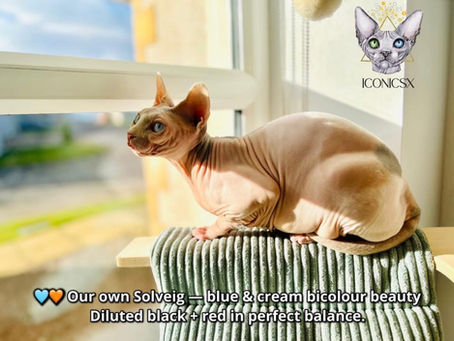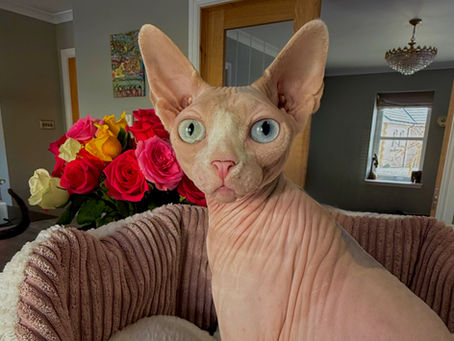top of page


GENES DON’T LIE — Why Almost Every tortie Cat Is a Girl (and Why Male Torties Are So Rare)
You’ve seen them — those striking, fiery-coloured cats with a patchwork of black, red, sometimes softened with cream or kissed with a splash of white. They’re called torties, short for tortoiseshell. Bold in colour, bold in personality. But here’s the thing: Almost all torties are female. No, it’s not magic. It’s genetics. What makes a tortie? A tortie is a cat that shows two pigment colours: • Black-based (eumelanin) • Red-based (pheomelanin) To display both, the cat must
Iconicsx
Oct 202 min read


GENES DON’T LIE - Dilution Gene — When Colours Go Soft
Not every pastel is what it seems. And not every blue is actually… blue. There’s a little gene (we call it dilution - “d”) that changes the way colour shows up in a cat’s coat — or skin, if you live with a Sphynx. It doesn’t wipe out the pigment; it just spreads it differently. Think of it like mixing paint with water. The colour’s still there, just softer. But here’s the catch: That only happens if the cat gets two copies of the gene (d/d) — one from each parent. Just one?
Iconicsx
Oct 202 min read


GENES DON’T LIE - White Spotted Gene — How Much White Is Too Much White?
You’ve probably seen them — those dreamy white-and-colour cats with just a splash of black on the head, or a tail like it was dipped in paint. They’re called van or harlequin, and their colouring comes from a gene called white spotting — or ws for short. But here’s the twist: Not every cat with this gene looks the same. Some have just cute little socks or a white belly…Others are almost completely white — and yet they don’t carry the gene for dominant white (w) at all. So wha
Iconicsx
Oct 203 min read


GENES DON’T LIE — White Isn’t Just a Colour.
Imagine this: You’ve got a full painting underneath — rich colours, perfect patterns, a story written in genes. Black, blue, tortie…maybe even a classic tabby. But then? Someone pulls a pure white curtain over the whole canvas. And just like that — poof. It’s all gone. That’s what the white gene (symbol: W) does. It’s not really a colour gene in the traditional sense. It’s more like a genetic blackout. Let’s talk about it. What does it do? Just one copy (w/W) is enough to tur
Iconicsx
Oct 202 min read


GENES DON’T LIE : Dominant or Recessive Genes? It Makes All the Difference.
Every cat is a walking story. But that story doesn’t begin with their first breath, or with the first cry in the nest box. It begins earlier — quietly — in the places we can’t see. In the double helix. In the script written long before we even knew their name. Each kitten carries two copies of every gene. One from the mother, one from the father. Sometimes, those genes agree. And sometimes… they don’t. When that happens, one must speak louder. That’s when we meet two fundame
Iconicsx
Oct 202 min read


GENES DON’T LIE : Phenotype vs Genotype - What You See vs What They Really Carry
Every cat has two stories, although most people only notice one of them. The first story is simple because it is written on the surface: the colour of the coat, the shade of the eyes, the length of the body or the shape of the head, the kind of things you notice immediately when you look at a photograph. The second story is harder to read because it is hidden in the genetic code, and even when it does not show on the cat itself it can still be passed on to the kittens, often
Iconicsx
Oct 202 min read


GENES DON’T LIE - Chimera Cat
Chimera cats. People throw that word around too much. Have you seen a cat with a split face and odd eyes advertised as „Chimera”? Most of the time, it’s not. A chimera cat isn’t about looks – it’s about DNA. This phenomenon occurs when, at a very early stage of embryo development, two separate embryos fuse together to become one body. As a result, a cat is made up of two different genetic sets. It depends on what fused: XX/XX – Two female embryos → Female cat, quite often
Iconicsx
Oct 202 min read


✨ First DBE Celestial in Sphynx Breed Confirmed ✨
We are proud to announce that IconicSX Cattery is home to the first Sphynx cat with a genetically confirmed DBE Celestial gene. O ur Queen Sofia is genetically confirmed heterozygous N/ DBECEL, one of the safest Dominant Blue Eye (DBE) genes recognised today. This line is the best studied and well known for its genetic health*, making it a cornerstone of our breeding program. The DBE-CEL gene , previously classified under the DBE-Altai group, was officially identified and d
Iconicsx
Jan 63 min read


HCM in Sphynx Cats : A Closer Look at the Recent ALMS1 and HCM Study: Are We Missing the Full Picture?
There has been growing discussion among breeders about the ALMS1 gene and its connection to hypertrophic cardiomyopathy (HCM) in Sphynx cats. However, some misunderstandings have arisen, particularly in interpreting the clinical data from a recent study. The study focused on a relatively small sample of 55 Sphynx cats. While the data offers valuable insights, it’s important to note that conclusions drawn from such a limited sample should be viewed cautiously. Additionally, si
Iconicsx
Oct 31, 20245 min read


Gene Testing in Sphynx Cats : Why Extensive Gene Testing Is a Responsible Choice—Even If some genes are Not Yet Linked to the Sphynx Breed.
Recently, I learned that some discussions in a local Facebook group involved mockery of my choice to test my cats for a wide range of genetic markers—beyond those typically associated with the Sphynx breed. It’s ironic, really, how some people seem more focused on exposing their own ignorance than on improving their breeding practices. So, let me set the record straight and focus on what really matters: the health and future of the breed. Exposing Ignorance Let’s start with t
Iconicsx
Oct 31, 20242 min read


Understanding HCM in Sphynx Cats: Promoting Healthy Breeding Practices
Did you know that having one copy of a particular gene can result in a dangerous heart problem in Sphynx cats? This condition is called Hypertrophic Cardiomyopathy (HCM), and cat owners and breeders should be aware of this genetic tendency. When researchers found the HCM gene in Sphynx, breeders and owners learned that roughly 75% of Sphynx had at least one copy of the affected gene. HCM is a genetic disorder that passes down through dominant genes. If a cat gets just one cop
Iconicsx
Jul 5, 20244 min read
bottom of page


